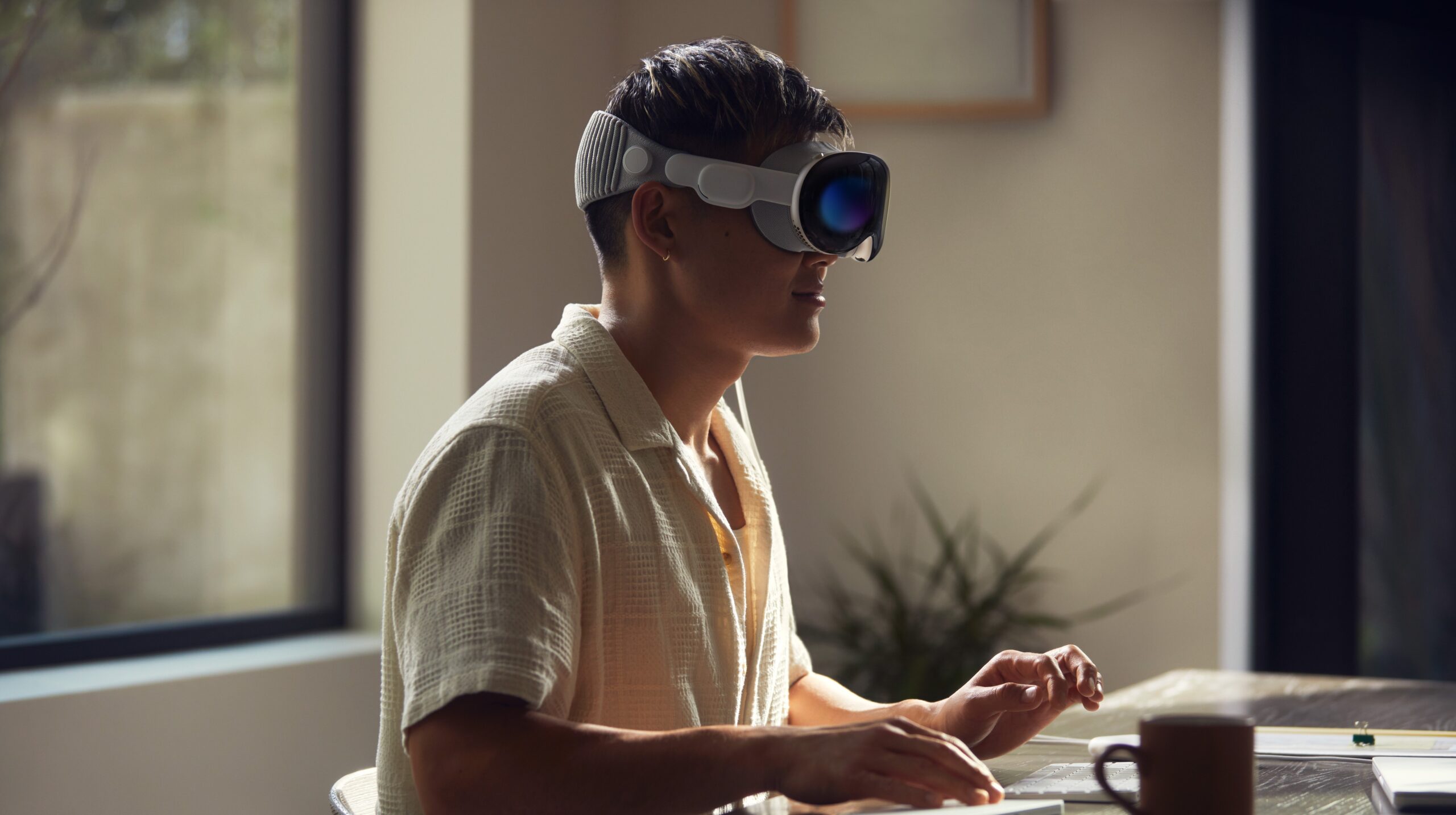Spatial computing is a relatively new area of IT that everyone from experts to end-users is expecting a lot from. According to some, the Vision Pro® announced by Apple® at WWDC23, which is currently aimed at the pinnacle of Spatial Computing, is reminiscent of the revolutionary moment in 2007 when the now worldwide success iPhone® first came on the scene. But it was an equally huge step, when the Macintosh® was announced - with its very memorable advertising. So, Apple is not lying about its innovative and forward-looking announcements. But before we delve even deeper into the potential that this new branch of computing has to offer; it is worth clarifying the concept itself.
Spatial Computing is an interesting choice of name for the concept Apple presented with Vision Pro. However, it is not just a catch-all term for AR (Augmented Reality), Mixed Reality, VR (Virtual Reality) and the tools that combine them but is actually much broader and older. Spatial computing includes, for example, GPS, the Internet of things, but also speech and gesture recognition, like Siri® and Alexa. Thus, Vision Pro was not the first to introduce this concept, but there is no doubt that this device can and will take it to a new level. Especially as the latter is primarily a new player in 'spatial computing' and only indirectly belongs to the concept.
Vision Pro, on the other hand, was clearly not referred to as AR or VR at the keynote, and instead of those terms, they explicitly insisted on the name Spatial Computing. There is a lot of speculation on this issue, as it is no coincidence that Apple wanted to phrase it differently. One of the reasons is that Vision Pro will be a device that can accommodate AR and VR technology, so that applications developed for it can use AR and VR, but the device itself is more than that, it is a serious attempt to use AI. Many of the Vision Pro's cameras and even more sensors work with data such as the user's heartbeat, pupillary responses, and reactions to small sounds that are not consciously noticeable to them, from which visionOS® builds its own machine learning and uses it to control processes. Looking at it from this angle, Vision Pro is quite different from previous attempts at AR and VR, very simply put, it is a device designed to be significantly more intelligent.
What most people want to know - apart from the experience of using it, of course - is in what sectors, apart from its clear entertainment role, we will be able to exploit the new opportunities that Vision Pro offers. One of these potential sectors is manufacturing, where the development potential of Xcode® and RealityKit could be put to excellent use in modelling and design. Warehouse work can also be greatly accelerated by the use of spatial computing, for example, warehouse workers can see through a huge hangar more efficiently if it is displayed in front of them as a 3D model, or even see the route to a particular package in front of them at all times. There is undoubtedly plenty of room and probably a need for the implementation and development of spatial computing in logistics.
Another potential use, mentioned by many, could be in retail, where retailers from clothing stores to home designers want to increase sales of specific products by dramatically enhancing the customer experience. A home design business can provide a much more interactive customer experience if it can take advantage of this technology and involve the customer in the lifelike design. Of course, there are all kinds of simulators and 3D design software that can give you a very accurate picture, but there is no doubt that it is completely different to experience it in a realistic, life-size, walking, experience. In the same way, the fashion industry can also benefit a lot from it, as customers don't have to leave their homes to try on clothes, which not only saves time and energy, but also gives them a lot more options when combining clothes and accessories. It can also be a great opportunity for real estate agencies, also giving potential clients the opportunity to view a property from home or from the office. Most of these of course assume that the individual also has a Vision Pro.
The new generation of simulators adapted to Vision Pro could play a significant role in education in the fields of driving, pilot training and even medical training. It can provide new opportunities for studying and practizing serious surgical procedures, as well as for recognizing and handling traffic situations.
Of course, the device could also be of great use in the corporate world, as Apple itself strongly emphasized in this year's keynote, but this is perhaps less of a concern for developers, as Apple's workplace applications will be available for visionOS. But taking on a more complex role, many can imagine it in medicine and professional sports as an interactive visualization and learning tool. What is perhaps another exciting insight is that some can even imagine the device for therapeutic, psychological use, which can provide patients with an experience and atmosphere outside the four walls. We know that this would be a huge step forward in therapeutic strategies, and I personally think it is a great idea that the medical and psychology world should pay attention to in the future. Similarly, in marketing, there are many potential uses for the technology, which could make the customer and consumer experience more interactive and personal. It should be noted that this is something relatively new and still only theoretical, but these speculations will shape and guide future applications and uses, and it is important to engage with them.
In addition, although it is a more abstract concept in itself, Vision Pro is predicted to play a major role in facilitating decision-making, based purely on the idea that good and fast decision-making requires as much information as possible. Obviously, a tool that strongly breaks down physical barriers or simplifies the examination of a topic can provide its user with significantly more information. However, it should be noted here that there is no concrete application or planned development to be associated with this at the moment, only a potential use of the possibilities offered by Vision Pro, and mostly in the business/workplace world.
The other essential question is what the future of Vision Pro will be. To put it in very broad terms, what will determine its success, what will shape Apple's development of visionOS, and, since we are talking about a really innovative product, is there a real demand for it? There is no doubt that there is a lot of excitement about the product. It’s not exactly cheap, but some people compare it to the Apple Pro Display XDR®, and indeed, as a replacement for that, it costs almost half as much. However, it is still a brave step from Apple, its market segment and purpose is not yet clear, nor are the exact details (which we have previously discussed on our blog), so the first round seems to be a test phase with a small number of mostly tech-savvy users and potentially larger companies, through whom it will be decided whether there is a real market demand for such glasses, or whether Apple has moved too early and the subject will only be revisited again decades later.
It’s natural that there are many speculations and discussion on the subject, but everyone agrees that the enthusiasm the Vision Pro has generated among developers is a promising sign, although the amount of development made for visionOS will really depend on whether there is a quantitative demand (and user base!) for the product. But time will tell.
There are concerns about the use of spatial computing as well, and it is a good question how well it will address the most pressing issue of our time, data protection, as these devices collect a lot of information about our environment. In addition, they are still available at a high price, which makes it a challenge not only for individuals but also for a large number of businesses to aquire the Vision Pro or other spatial computing related products. Wall Street has published very different estimates, ranging from 250,000 to 1.5 million units as the expected number of sales during Vision Pro’s initial year. There is no consensus on the stock market as to whether this innovation is worth it for Apple, but all admit undoubtedly that this step is revolutionary regardless.
For many people, it must be difficult to get used to such a new way of doing things, and there is no doubt that the image of a dad playing with his children and filming them wearing a headset seems strange and futuristic even to tech-fans, but perhaps that is the least of the obstacles.


